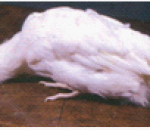Molting is a natural, physiological process to renew old feathers at the end of first year of laying.
The time and duration of the first annual molting are important points in distinguishing the poor and good layers. During the molting period, the reproductive system of the bird is allowed a complete rest from laying and the bird builds up its body reserves of nutrients.
During molting process, the feathers on different parts of the body are shed in the following manner:
Head … neck … breast … body … wings … tails
The wing comprises primary feathers (primaries) and secondary feathers (secondaries). Primary feathers are also known as ‘flight’ feathers and during molting, they shed before secondaries. They have a definite shedding order starting from one side and ending towards the end of the wing. Secondaries are smaller and softer than primaries and they shed without any order.

Early moulters are usually poor layers. Such birds start molting early and take usually a long time (24weeks or so) to complete molting. They shed only one primary feather at a time at the intervals of two weeks during the molting period. In contrast to this, good layers start molting late during their first year of laying. Good layers complete the molting quickly by shedding two or more primaries together. They may sometimes continue to lay during the molting period. The process of molting is completed only in 6 weeks whereas poor layers may take 6 months.
when do chickens molt?
Chickens can molt at any time during the year when they are subjected to stress. Normally, hens molt during the autumn season when the egg production or laying cycle ends. The chick goes through one complete and three partial molts during its growth to point of lay, after which the mature bird normally undergoes one complete molt a year.
why do chicken molts?
Chickens molt to build up their energy reserves and ensure their body maintenance. Physical exhaustion and reduced feeding time due to decreased day length also lead to molting. Hens lay eggs during a definite period or laying cycle and after its completion, they molt.
Here is the list of some common stress factors that can induce molting
1. Variation in Light Duration
2. Marked decrease in bodyweight
3. Parasitic infestation
4. Debilitating disease
5. Extreme climatic change
6. Insufficient feeding or nutrient deficiency
7. Prolonged broodiness
8. Stress of Vaccination & debeaking
9. Overcrowding & faulty ventilation
10. Fright of wild birds and children
Four phases of molting
1. Pre molt phase
2. Initiating molt
3. Resting phase
4. Bring flock back to production
Pre-Molt Phase
Before the initiation of molt, a pre molt period of one week should be provided to birds.
During this period, following steps should be ensured
1. Check health status of the flock
2. Check external parasites if present dip the bird in “nicobalm solution”
3. Check feather follicles for lice if present allow the birds for dust bath
4. Check internal parasites use dewormer “pipperazine”
5. Apply some broad spectrum antibiotics such as “Neomycin”, “Tylosin”, “Chloramphenicol”
6. Check the bird titer for ND/IB and vaccinate if necessary
7. Classify and categorize birds according to body weight categories
The lighting and feeding must be 24 hour and ad-lib. Respectively.
Initiating Molt
1. All moulting programs require that egg production be reduced to zero, which is usually accomplished by fasting (no feed) the flock or by limiting critical nutrients such as protein, calcium, or sodium until or beyond the time production ceases.
2. Some producers include 1 or 2 days of water removal to help get the flocks out of production, but this action is not necessary and creates certain risks, especially during summer months.
3. Artificial lights should be turned off in open house and reduced to no more than 8 hours in environmentally controlled housed.
Resting Phase
1. Once the flock is out of production, it may be held out of production for as little as one week to as much as 4 or 5 weeks depending on the intent of the manager and the feeding program implemented during this period.
2. A short resting period can get a flock back to peak production in 4 or 5 weeks from initiation of the molt, or if the intended second cycle period is to be less than 6 months in length. Shorter rests, though are usually associated with lower rates of egg production and poorer egg shell quality.
Returning to Laying
1. In summer months the birds will be back from moulting in 35 days while in winter they take almost 42 days.


